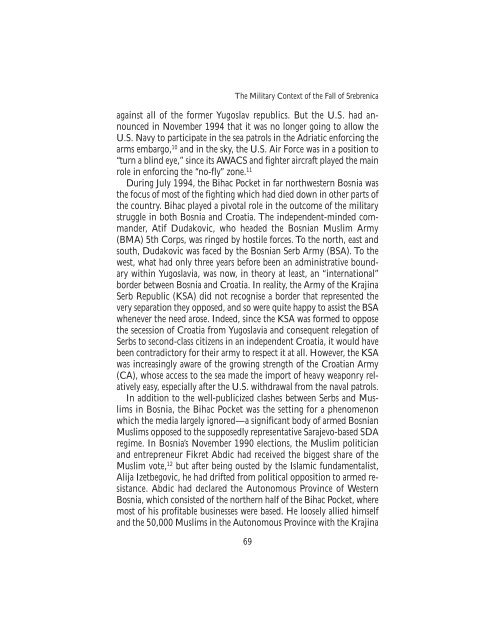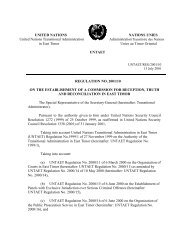The Srebrenica Massacre - Nova Srpska Politicka Misao
The Srebrenica Massacre - Nova Srpska Politicka Misao
The Srebrenica Massacre - Nova Srpska Politicka Misao
You also want an ePaper? Increase the reach of your titles
YUMPU automatically turns print PDFs into web optimized ePapers that Google loves.
<strong>The</strong> Military Context of the Fall of <strong>Srebrenica</strong><br />
against all of the former Yugoslav republics. But the U.S. had announced<br />
in November 1994 that it was no longer going to allow the<br />
U.S. Navy to participate in the sea patrols in the Adriatic enforcing the<br />
arms embargo, 10 and in the sky, the U.S. Air Force was in a position to<br />
“turn a blind eye,” since its AWACS and fighter aircraft played the main<br />
role in enforcing the “no-fly” zone. 11<br />
During July 1994, the Bihac Pocket in far northwestern Bosnia was<br />
the focus of most of the fighting which had died down in other parts of<br />
the country. Bihac played a pivotal role in the outcome of the military<br />
struggle in both Bosnia and Croatia. <strong>The</strong> independent-minded commander,<br />
Atif Dudakovic, who headed the Bosnian Muslim Army<br />
(BMA) 5th Corps, was ringed by hostile forces. To the north, east and<br />
south, Dudakovic was faced by the Bosnian Serb Army (BSA). To the<br />
west, what had only three years before been an administrative boundary<br />
within Yugoslavia, was now, in theory at least, an “international”<br />
border between Bosnia and Croatia. In reality, the Army of the Krajina<br />
Serb Republic (KSA) did not recognise a border that represented the<br />
very separation they opposed, and so were quite happy to assist the BSA<br />
whenever the need arose. Indeed, since the KSA was formed to oppose<br />
the secession of Croatia from Yugoslavia and consequent relegation of<br />
Serbs to second-class citizens in an independent Croatia, it would have<br />
been contradictory for their army to respect it at all. However, the KSA<br />
was increasingly aware of the growing strength of the Croatian Army<br />
(CA), whose access to the sea made the import of heavy weaponry relatively<br />
easy, especially after the U.S. withdrawal from the naval patrols.<br />
In addition to the well-publicized clashes between Serbs and Muslims<br />
in Bosnia, the Bihac Pocket was the setting for a phenomenon<br />
which the media largely ignored—a significant body of armed Bosnian<br />
Muslims opposed to the supposedly representative Sarajevo-based SDA<br />
regime. In Bosnia’s November 1990 elections, the Muslim politician<br />
and entrepreneur Fikret Abdic had received the biggest share of the<br />
Muslim vote, 12 but after being ousted by the Islamic fundamentalist,<br />
Alija Izetbegovic, he had drifted from political opposition to armed resistance.<br />
Abdic had declared the Autonomous Province of Western<br />
Bosnia, which consisted of the northern half of the Bihac Pocket, where<br />
most of his profitable businesses were based. He loosely allied himself<br />
and the 50,000 Muslims in the Autonomous Province with the Krajina<br />
69



